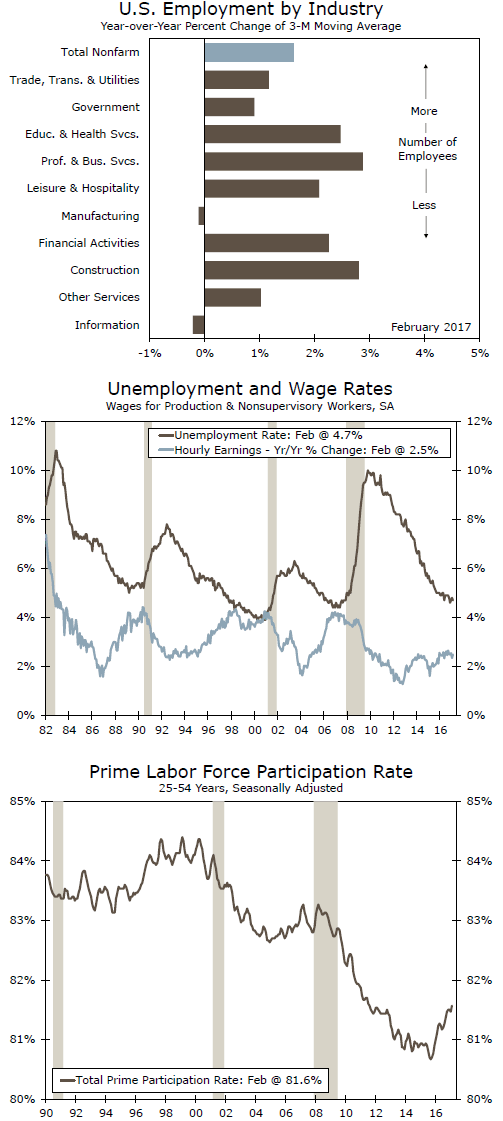Over the past three months, labor market gains in the form of jobs and wages support consumer spending and a continued domestic economic expansion. Labor force participation remains a long-term issue.
Jobs Up 235,000 in February: Solid Hiring Start in 2017
Nonfarm payrolls rose a solid 235,000 in February, boosting the three-month average to 209,000. Gains were strong across the private sector, with employment rising by 227,000 and an additional 8,000 jobs in the government sector. Retail was the one area of weakness–down 26,000. Manufacturing employment posted another monthly gain (up 28,000), matching the largest monthly increase since mid-2013. Construction hiring was solid at 58,000 but was likely helped by mild winter weather.
Outside the goods-producing industry, there has been broad-based strength in job growth over the past year, particularly in business services, education & health and leisure & hospitality (top chart). These gains are consistent with solid consumer spending and continued economic growth. Aggregate hours worked are up 3.1 percent on a three-month annualized rate, which is consistent with domestic strength. We currently project real final sales to grow 2.0-2.5 percent in the first quarter, but headline real GDP growth will likely be a lower 1.5-2.0 percent due to the drag on growth from trade and inventories.
Average Hourly Earnings Gains Sustained
Average hourly earnings rose 0.2 percent in February and are up 2.8 percent year-over-year, sustaining recent gains and providing further support for a March rate hike. As illustrated in the middle chart, the pickup in wages has been modest compared to prior cycles. With economic growth and wage growth still far from a break-out pace, the Fed will likely continue to take its time tightening policy for the remainder of the year.
However, the pace of wages does not reflect gains in benefits and the impact of longer hours worked, particularly in both durable and nondurable manufacturing. Our proxy for aggregate income growth is up 4.7 percent on a three-month average annualized basis, supporting the case for continued gains in consumer spending—no slow down there.
Aggregate Demand or Supply? Depends on Your Time Horizon
Growth does not live by stimulating aggregate demand alone. To achieve and maintain economic growth over three percent without accelerating prices, policymakers are challenged to stimulate the supply-side of the economy. The labor force participation rate rose again in February to 63.0 percent. The prime-age participation rate also increased slightly, reaching its highest level since 2011 (bottom chart).
However, labor force participation rates face long-run, secular headwinds that go beyond a short-run cyclical improvement drawing workers back into the labor market. There is no quick fix, but focusing on improving both the quality and quantity of the labor force will be key to driving faster, sustainable economic growth.














